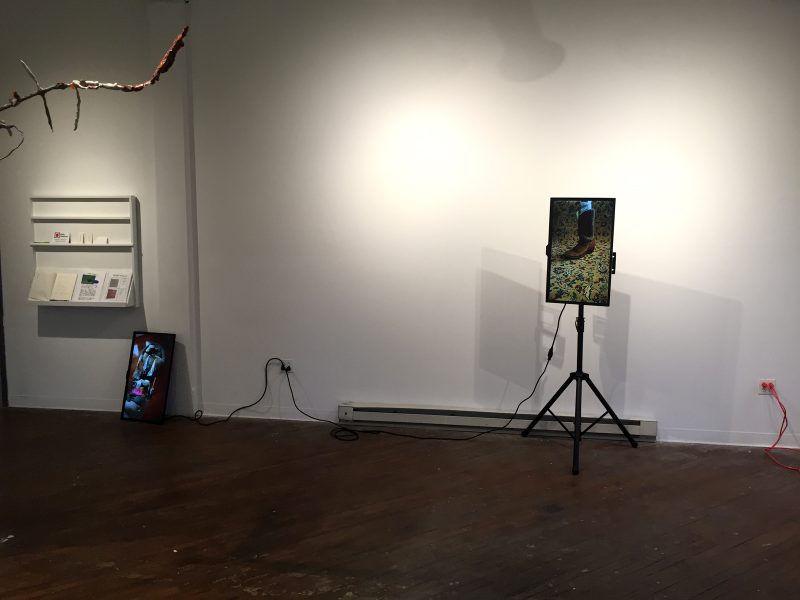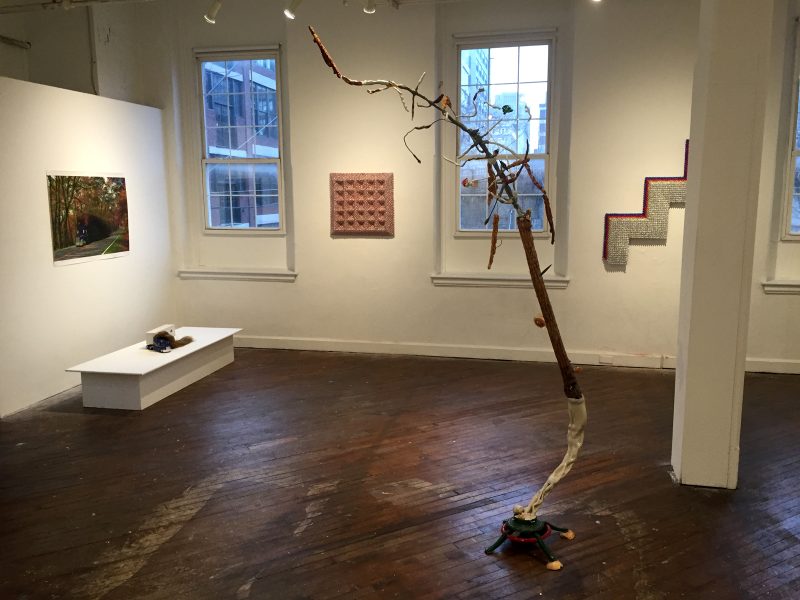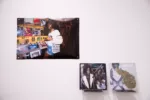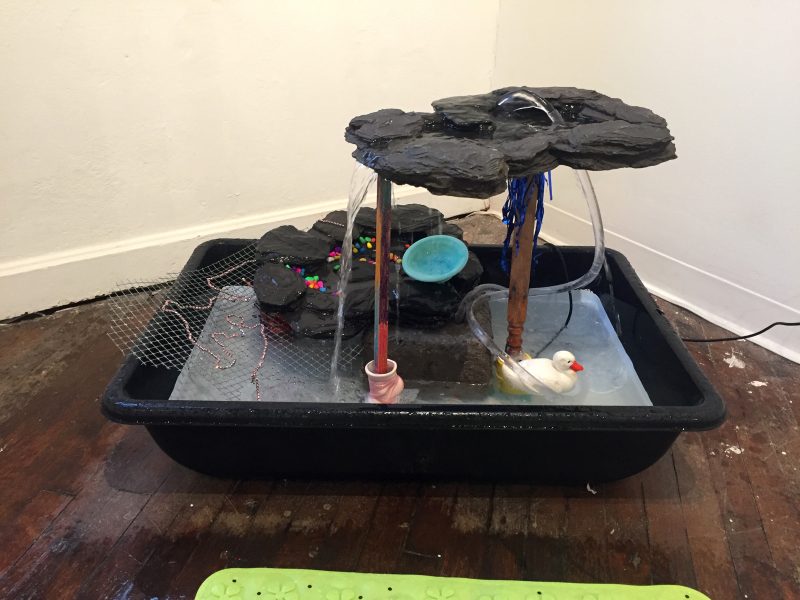
“Camp” is having a moment. Perhaps that moment started last year, as the theme of the 2019 Met Gala. Perhaps it started sooner–as far back as Susan Sontag’s 1964 essay “Notes on ‘Camp’”–maybe even earlier than that. To be sure, the concept is one that stretches back in human history, and art history: think of gilded royals dressed up in feathers and pearls and fabulous brocades. Or, think more organically: peacocks. Elegant or campy? It can be quite a fine line.
CAMP Philly, on view at Automat through February 1, wrestles with campiness through the work of three local artists: Kelly Dzioba, Zach Hill, and Natasha Le Sourd. Fabulously, the show opened on January 10 – the anniversary of the death of Philly-favorite David Bowie. Bowie can perhaps be thought of as the fairy godparent of the show, himself embodying camp during the Stardust Years (1972-73). The materiality in the show echoes his fabulous hair, makeup, costumes, and–above all–attitude. Arguably, the key ingredient in baking up a campy masterpiece.
Sontag called camp a “love of the unnatural: of artifice and exaggeration.” To create a show of such grandiosity was a bold undertaking for Tessa Haas, organizer of CAMP Philly. I applaud Haas’s spirit. To enter the show, one must walk (or, if you want to get into the spirit of things, sashay) through a purple fringe curtain. Through the shiny material, you catch glimpses of the work. While individually the 11 pieces on view are extravagant, you might be surprised at the overall sparseness of the space. Though at first I found this to be a break with the overall theme, I eventually settled in to thinking that the show is rather like a stage: each work having their own spotlight, rather than becoming too much an ensemble affair.
Kelly Dzioba’s work frames the gallery: sculptures made of aptly named “party beads” in metallic colors: blush, silver, gold, and multicolored. They have a real depth to them, appearing almost holographic, with a kind of futuristic, clubby vibe. One in particular, “Stepped” (2019), balances a kind of drag show fabulosity with visual references to iconic artists such as Josef Albers. One work in particular, “Asscher,” made me look twice. At first I thought the title of the silvery, geometric piece was referring to a play on a boy’s name, or (immaturely) even a reference to butts. A quick Google search put me in my place when I found that in fact Asscher is an incredibly elegant cut of diamond. I was further amused by Dzioba’s playfulness after that discovery: to build an expensive diamond shape from the frivolity of Mardi Gras beads! Wonderful.

The work of Natasha Le Sourd lies close by. At first glance, I was drawn to two works presented together: “TRUCK my truck #1” and its companion image “Truck in the forrest.” This is a majestic photo of the wind whipping back the truck’s luscious locks. I found it quite amusing, and couldn’t help but think of Billy Ray Cyrus (“Old Town Road,” anyone? C’mon – even though it’s *technically* Lil Nas X’s song, we know that BRC’s hair is really the star). Hair continued as a motif in the nearby work “Samson,” a kind of Addams-family-stop-light situation. It is strange, the hair is almost glittery up close. Perhaps this artwork is a form of hypnosis?
Of Le Sourd’s work on view, I was most engaged by “Fountain Model” (2019), a mysterious object sitting unassumingly in the corner. A fountain is generally something grandiose: marble, majestic, iconic. Le Sourd has flipped that idea on its head, creating a fountain of rocks, a toy duck, chicken wire… a hodge-podge, a collection of objects that is at once uncanny and dream-like. The sound of the water can be heard around the gallery, giving a strangely calming effect to the wild space. Is this object camp? I’m not convinced. But, at the very least it is enchanting, and definitely checks Sontag’s “artifice” box.
Zach Hill provides the remaining three objects to the show: two videos, and a central installation that anchors the gallery. The videos–“Pet” and “Hermit Crab” (both 2018)–both feature a creepy hand. Made of fake nails, tape, straws, pearls, and other junk, the hand is a hermit crab in one video, slowly sliding in and out of its “shell” (a boot); and in the other video it is an ominous petting device, coming to torture a dog. In both videos, the hand is a kind of scary sock puppet– childs’ theatre on a bad acid trip–it is off putting but riveting, I couldn’t look away. Watching “Hermit Crab,” I was transfixed by the retro carpeting and slow motion of the dumpy crab hand – I couldn’t help but think of the “Shiny” song from the Disney movie Moana, which made it even better in the context of camp. With “Pet” the quiet, occasional growls added a nice balance to the trickling water sound from Le Sourd’s work across the gallery. Campy? Sure, certainly unnatural.
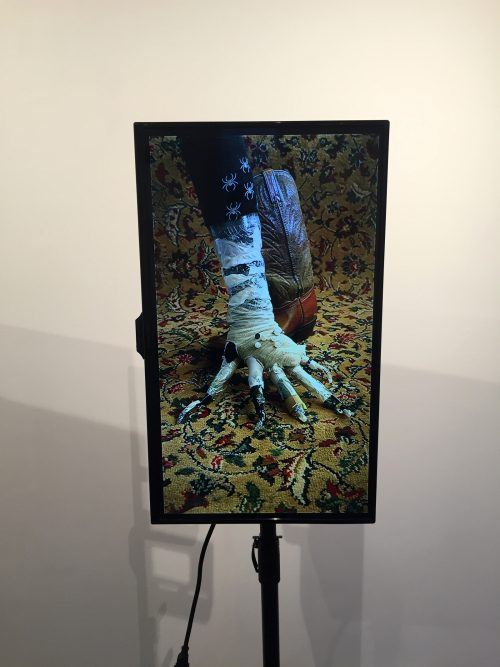
Finally, the central work: acting like Peter Pan’s missing shadow, taunting you just out of reach, always unidentifiably at your back. The material list for “Christmas Tree” (2018) is extensive: epoxy, corn stalk, wire, wallpaper, sea shells, latex, fake nails, cereal… A kind of Frankenstein, the installation is made of a seemingly-random mix of items. Hill seems to mock the concept of a Christmas Tree: adding popcorn, glitter, ornaments, a little tree skirt, a star, to something that is just fine on its own. Hill has brought a new dimension to the idea of gilding the lily: creating both the thing itself and the excess to the nth degree. In that way, perhaps this object comes the closest to being a camp masterpiece: something so odd, but so nonchalant in its strangeness that it seems both perfectly normal and totally amazing all at once. Even the angle of the leaning tree gives it an attitude, like a T-bird smoking a cigarette without a care in the world, hair greased to perfection.
I left the show entertained, and have continued to think about the objects since – the mark of a good exhibition. That said, I do feel that the concept could have been pushed further. While great art is about precision and knowing when enough is enough, camp is about more. So great campy art must then mean that more is more, and I certainly could have had another serving. All in all, CAMP Philly is a romp through a glitzy, uncanny wonderland. Would I sign up for another year at this CAMP? Absolutely.
“CAMP Philly” at Automat Collective, January 10 – February 1, 2020
More Photos
